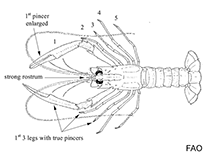Metanephrops formosanus Chan & Yu, 1987
Formosa lobster| Native range | All suitable habitat | Point map | Year 2050 |

|
| This map was computer-generated and has not yet been reviewed. |
| Metanephrops formosanus AquaMaps Data sources: GBIF OBIS |
Upload your photos
Google image | No image available for this species;
drawing shows typical species in Nephropidae.
Google image | No image available for this species;
drawing shows typical species in Nephropidae.
Classification / Names Common names | Synonyms | CoL | ITIS | WoRMS
Malacostraca | Decapoda | Nephropidae
Environment: milieu / climate zone / depth range / distribution range Ecology
Benthic; depth range 150 - 400 m, usually 250 - ? m. Tropical; 26°N - 21°N, 119°E - 124°E (Ref. 4)
Distribution Countries | FAO areas | Ecosystems | Occurrences | Introductions
Indo-west Pacific: Taiwan.
Length at first maturity / Size / Weight / Age
Maturity: Lm ? range ? - ? cm Max length : 12.0 cm TL male/unsexed; (Ref. 122061); 9.5 cm TL (female)
It has lengths of 5 to 12 cm (males) and 5 to 9.5 (females), total body length; 8.5 cm, ovigerous female; most specimens are 9 cm long; 1.8 to 4.1 (males), 1.7 to 4.8 (females) and 3.1 to 4.0 (ovigerous females), carapace length (Ref. 4). Occurs at depths from 150 to 400 m, mostly around 250 m with muddy or sandy bottom (Ref. 4).
Life cycle and mating behavior Maturity | Reproduction | Spawning | Eggs | Fecundity | Larvae
Spawning time seems to be in late autumn (Ref. 4).
Main reference
References | Coordinator | Collaborators
Holthuis, L.B. 1991. (Ref. 4)
IUCN Red List Status (Ref. 130435)
Data deficient (DD) ; Date assessed: 03 December 2009
CITES status (Ref. 108899)
Not Evaluated
CMS (Ref. 116361)
Not Evaluated
Threat to humans
Human uses
Fisheries: commercial
| FishSource |
Tools
More information
Age/Size
Growth
Length-weight
Length-length
Morphology
Larvae
Abundance
Growth
Length-weight
Length-length
Morphology
Larvae
Abundance
Internet sources
BHL | BOLD Systems | CISTI | DiscoverLife | FAO(Publication : search) | Fishipedia | GenBank (genome, nucleotide) | GloBI | Gomexsi | Google Books | Google Scholar | Google | PubMed | Tree of Life | Wikipedia (Go, Search) | Zoological Record
Estimates based on models
Preferred temperature
(Ref. 115969): 11.7 - 17.4, mean 16.3 (based on 8 cells).



